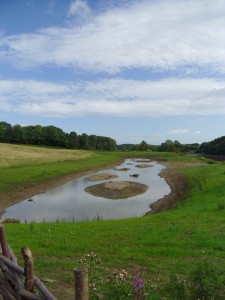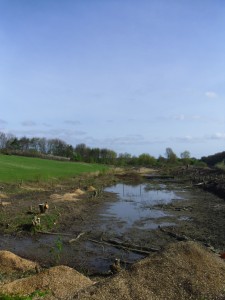New £120K habitat-creation project unveiled

An example of one of the UK’s rarest habitats is being unveiled to the public at WWT Washington Wetland Centre this weekend.
A £120K saline lagoon, funded by SITA Trust and the Estate of the late Mrs M A Sheard, has been created to strengthen the biodiversity of the site’s wildlife reserve by connecting it to the River Wear.
Saline lagoons are among the UK’s rarest habitats and their brackish nature – a mixture of fresh and sea water – provides the ideal salinity levels for a unique range of wetland species.
Centre manager Gill Pipes said: “This is an exciting and diverse new habitat which strengthens the relationship between our site and the River Wear.
“We are hugely grateful to our funders for allowing us this opportunity to work together in enabling our visitors to get closer to mammals such as roe deer and otter, plus a wider range of birds and flora.”
The saline lagoon project saw the transformation of an old area of WWT Washington’s nature reserve known as Sandpiper Ponds and began with extensive plant and invertebrate surveys in 2011, followed by the lagoon’s excavation and creation in 2012 and finishing works in 2013.
The new habitat floods during spring high tides of five metres or more and when the tide is low, the land still retains pools of water.
The spoil from the excavation (some 100,000 cubic metres or 14,285 Transit van-loads!) has been deposited at either end of the lagoon, raising the area substantially and creating fantastic vistas across the habitat itself and down along the Wear.
Mud islands have also been built up along the middle of the lagoon. These are topped with pea gravel and will provide essential nesting habitat for wading birds.

At the top of the meadow overlooking the lagoon, a meandering footpath is lined with newly-planted hedgerows, which will create a subtle screen to allow the public to get close to the wildlife below without disturbing it.
Jools Granville of SITA Trust, which provides funding through the Landfill Communities Fund for projects that enhance communities and enrich nature, added: "WWT Washington is a very important site for both its biodiversity benefits and its engagement with people.
“SITA Trust was delighted to provide this much-needed funding to enable WWT to bring together people and nature for the benefit of both.
“In the fifteen years we have been offering funding in this region we have been able to work with WWT on a number of projects and we are always delighted with the results - we hope that the visitors, both feathered and human, are too!
The saline lagoon will open at 9.30am on Saturday 25 May and staff will be on hand throughout the day with more information about this important habitat creation project. Join us for a tour during high tide and see the lagoon flood (meet in the picture window at 3pm, cost included in admission).
Creating a new habitat...a timeline of the saline lagoon...
2012
January 9 - contractors start work on the excavation of the new saline lagoon.
January - the realignment of the new perimeter fence is completed.
February - the old perimeter fence is removed and excavation work is completed.
March 7 - breach day! Spring tide floods in and fills the lagoon for the first time.
March - work starts on the new nature trail footpath, incorporating as many different habitats as possible; mature hawthorn wood, reedbed, the River Wear, lagoon, meadow and scrubby woodland glades.
May - the newly-formed lagoon meadow edge is sown with a BFS3 seed mix (80% low maintenance grasses for neutral/damp soils and 20% flora blend).
June - flash-flooding washes away the new nature trail footpath.
October - an otter holt is installed on the lagoon bank.
2013
February - tracks and signs indicate the otter holt is being used by a female and her young.
March - the visitor portals are installed.
April - work begins on repairing the nature trail footpath.
May 25 - the saline lagoon opens to the public.
A host of wildlife highlights...what’s been seen and what should be coming soon...
Saline lagoon:
Excavation work to transform the old Sandpiper Ponds into the expanse of saline lagoon that exists today began in January 2012.
Within days of the first spring tide breaching the riverbank on 7 March, otter tracks were noted around the lagoon edge. The realignment of the perimeter fox-proof fence also means that large mammals are able to access this part of the reserve for the first time in 40 years, and in the summer of 2012 a roe deer was regularly spotted.
During its construction, black-headed gull and grey wagtail were recorded most days on the lagoon. It is also worth noting that the winter-roosting curlew were still arriving in good numbers, undeterred by the work being carried out.
Once the lagoon had flooded, wildfowl such as mallard, gadwall, teal, shelduck and tufted duck quickly moved in. Waders such as lapwing, redshank and curlew have also been recorded. When the contractors left site, a pair of oystercatcher attempted to breed on the edge of the lagoon, but failed due to gulls predating their eggs. Also recorded in spring 2012 were a wheatear on the lagoon and a yellow wagtail on Wader Lake. Both of these species had not been recorded on site for many years.
Saline lagoons and saltmarshes are important feeding grounds for migrating and wintering bird species including wigeon, teal, barnacle goose, goosander, goldeneye, grebe, kingfisher and cormorant, as well as a host of wading species including oystercatcher, ringed plover, lapwing, dunlin, redshank, woodcock and snipe.
Underwater life can be difficult to spot, but fish and worms have been recorded and we hope for further colonies of crabs, snails and shrimps. The River Wear supports important stocks of migratory salmonids (salmon and trout) and in recent years sea trout have been increasing. Non-migratory fish communities include brown trout, grayling, lamprey and a range of coarse fish species such as dace, chub, gudgeon, bream, eel, stone loch, minnow and bullhead. The lagoon will regularly be topped up with water from the River Wear, allowing the fish to enter the lagoon.
Salt-tolerant lagoon plants, such as sea aster and sea plantain, have been rescued and relocated from a collapsed bank at Window on the Wear and will hopefully flower and seed this summer.
Lagoon meadow:
This grassland is managed for breeding wading birds such as lapwing and oystercatcher. These birds like to nest in grass that is long enough to hide their nest, but short enough to spot approaching predators. The new areas of lagoon meadow have been seeded with a mix of grasses and wildflowers including yellow rattle, ox-eye daisy, black knapweed and bird’s-foot trefoil. Once the wildflowers have started to flower, look out for peacock butterflies, small tortoiseshell, red admiral, bumblebees and hoverflies.
River reedbed:
The freshwater reedbeds to the east of the lagoon are an important habitat for wildlife and support breeding populations of whitethroat, sedge warbler, reed warbler and reed bunting. The latter is a biodiversity action plan priority species for the county. The fresh water from the reedbed allows us to dilute the salinity in the lagoon if we feel need to.
River Wear:
The River Wear is the lifeblood of our wildlife reserve and the reason that such a variety of species visit our site. In 1996, an otter was seen on the river for the first time in several decades. Now they are doing well throughout the North East. While you will still be lucky to see an otter here, you will certainly have a better chance than at any time in the last 50 years. Other highlights on the river include cormorant, goldeneye, goosander, redshank, tufted duck and even the odd seal.



